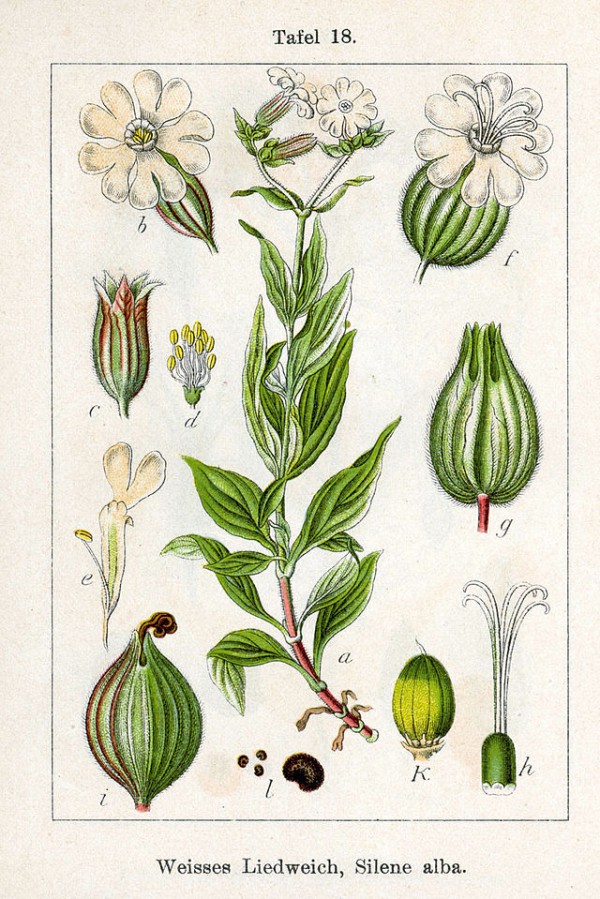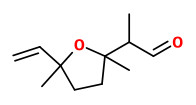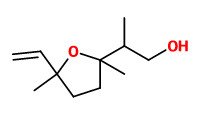Silene latifolia Poir. - syn. Silene alba (Miller) E. H. L. Krause - Caryophyllaceae
white campion, Weiße Lichtnelke
Herbaceous annual, occasionally biennial or a short-lived perennial plant, 40-80cm tall, native to Europe, Western Asia and Northern Africa, naturalised in North America. http://en.wikipedia.org/wiki/Silene_latifolia
Floral scent of S.latifolia was collected by headspace adsorption and analysed via GC/MS. Main components were lilac aldehyde A (15.1%), lilac aldehyde B (32.5%), 1,2-dimethoxybenzene (8.4%), benzyl acetate (5.5%), decanal (2.7%), nonanal (2.2%), limonene 1.5%), and E-beta ocimene (1.4%).
[Jürgens, A., T. Witt, and G. Gottsberger. „Flower scent composition in night-flowering Silene species (Caryophyllaceae).“ Biochemical Systematics and Ecology 30.5 (2002): 383-397]
„The quantitative and qualitative variability in floral scent of 98 specimens of the dioecious species Silene latifolia belonging to 15 European and 19 North American populations was determined. Floral scent was collected from single flowers using dynamic headspace methods, and analysed by Micro-SPE and GC-MS methods. The flowers showed a nocturnal rhythm, and scent was emitted only at night. The amount of emitted volatiles varied greatly during the season, from 400 ng/flower/2 min in June to 50 ng/flower/2 min in August and September. The qualitative variability in the floral scent was high and different chemotypes, characterised by specific scent compounds, were found. Female and male flowers emitted the same type and amount of volatiles. The differences in floral scent composition between European and North American populations were small. Typical compounds were isoprenoids like lilac aldehyde isomers, or trans-β-ocimene, and benzenoids like benzaldehyde, phenyl acetaldehyde, or veratrole. Some of these compounds are known to attract nocturnal Lepidoptera species. The high qualitative variability is discussed in relation to the pollination biology of S. latifolia, and the results are compared with other studies investigating intraspecific variability of flower scent.“
[Qualitative and quantitative analyses of flower scent in Silene latifolia. Dötterl, S., Wolfe, L. M., Jürgens, A., Phytochemistry, vol.66(2), 2005,203-213]
„… Hadena bicruris is attracted to the flowers of its most important host plant, Silene latifolia, by their scent… Phenylacetaldehyde elicited the strongest signals in the antennae, but lilac aldehydes were the most attractive compounds in wind-tunnel bioassays and attracted 90% of the moths tested, as did the scent of single flowers.“
Main components of the flower scent were benzaldehyde, myrcene, (Z)-3-hexenyl acetate, β-ocimene, phenylacetaldehyde, guaiacol, veratrole, lilac aldehydes, benzyl acetate, 3-phenylpropanal, lilac alcohols, and (E,E)-α-farnesene.
[Nursery pollination by a moth in Silene latifolia: the role of odours in eliciting antennal and behavioural responses., Dötterl, S., Jürgens, A., Seifert, K., Laube, T., Weissbecker, B., Schütz, S., New Phytologist, Vol.169(4), 2006, 707-718]
http://onlinelibrary.wiley.com/doi/10.1111/j.1469-8137.2005.01509.x/full
„The monoterpene lilac aldehyde is found in floral scent of several plants species, among them Silene latifolia. This plant is involved in a nursery pollination system, because a noctuid moth, Hadena bicruris, is not only pollinator but also seed predator. Lilac aldehyde is the key floral scent compound of S. latifolia for attracting Hadena…. In all samples only the (5'S)-configured stereoisomers were detected, and no (5'R)-configured stereoisomer was found. The most abundant isomer in all samples was either the (2S,2'S,5'S)- or the (2R,2'S,5'S)-configured stereoisomer. Both isomers reached a relative amount of ca. 40%, followed by isomer (2'S,2'R,5'S) with ca. 20% relative amount. The fourth isomer, (2R,2'R,5'S), occurred only in small amounts (0.7-3.0%).“
The most dominant compounds (reaching a relative amount of 20% at least in one sample) in the 18 studied populations were lilac aldehyde, benzyl acetate, veratrole, phenylacetaldehyde, and E-(ß)-ocimene.
[Stereoisomeric pattern of lilac aldehyde in Silene latifolia, a plant involved in a nursery pollination system. Dötterl, S., Burkhardt, D., Jürgens, A., Mosandl, A., Phytochemistry, Vol.68(4), 2007,499-504]

Silene latifolia Poiret as Silene alba
Sturm, J., Krause, E.H.L., Lutz, K.G., Flora von Deutschland in Abbildungen nach der Natur, Zweite Auflage, vol.5 t.18 (1901)
http://www.plantillustrations.org/species.php?id_species=947918
Silene latifolia
© Rolf Marschner (2016),
www.botanische-spaziergaenge.at



